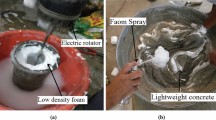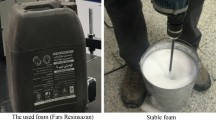Abstract
The demand for novel technology for manufacturing lightweight concrete has increased in the global construction industry. Therefore, studies that explore alternative lightweight concrete systems for structural applications are urgently needed. The objective of this study is to develop structural fibred-foamed concrete (SFFC) by the addition of polypropylene (PP) fibre, fly ash (FA), and silica fume (SF). Foamed concrete (FC) was obtained by replacing sand with FA. The properties of the FC were enhanced with PP fibre and fine SF. SFFC with dissimilar densities of FC (1000, 1300, 1600, and 1900 kg/m3) is essential for examining compressive, flexural, and splitting tensile strengths, drying shrinkage, and creep. The FC with a density of 1000–1900 kg/m3 and compressive and splitting tensile strengths of 10–70 MPa and 1.1–4.81 MPa, respectively, have been made by the addition of PP fibre and fine SF. Fine SF and PP fibre considerably improved the hardened strength of the FC. Additionally, the inclusion of PP fibre significantly enhanced the tensile strength and increased the creep resistance and drying shrinkage. Therefore, SFFC can be used as a substitute lightweight concrete material for the production of structural concrete applications in the construction industries today.






















Similar content being viewed by others
References
Amran YM, Farzadnia N, Ali AA (2015) Properties and applications of foamed concrete; a review. Constr Build Mater 101:990–1005
Nambiar EK, Ramamurthy K (2007) Air-void characterisation of foam concrete. Cem Concr Res 37(2):221–230
Ramamurthy K, Nambiar EK, Ranjani GIS (2009) A classification of studies on properties of foam concrete. Cement Concr Compos 31(6):388–396
Just A, Middendorf B (2009) Microstructure of high-strength foam concrete. Mater Charact 60(7):741–748
Jones M, McCarthy A (2005) Preliminary views on the potential of foamed concrete as a structural material. Magazine of concrete research 57(1):21–31
Cox L, van Dijk S (2002) Foam concrete: a different kind of mix. Concrete 36:2
Kearsley E, Wainwright P (2001) The effect of high fly ash content on the compressive strength of foamed concrete. Cem Concr Res 31(1):105–112
Narayanan N, Ramamurthy K (2000) Structure and properties of aerated concrete: a review. Cement Concr Compos 22(5):321–329
Karl S, Wörner J (1993) Foamed concrete-mixing and workability. In: Special concrete-workability and mixing. E & FN Spon London, pp 217–224
Kearsley E, Wainwright P (2001) Porosity and permeability of foamed concrete. Cem Concr Res 31(5):805–812
Amran YM, Ali AA, Rashid RS, Hejazi F, Safiee NA (2016) Structural behavior of axially loaded precast foamed concrete sandwich panels. Constr Build Mater 107:307–320
Amran YM, Rashid RS, Hejazi F, Safiee NA, Ali AA (2016) Response of precast foamed concrete sandwich panels to flexural loading. J Build Eng 7:143–158
Amran YM, Rashid RS, Hejazi F, Safiee NA, Ali AA (2016) Structural behavior of laterally loaded precast foamed concrete sandwich panel. Int J Civil Environ Struct Constr Archit Eng 10:3
Singh D, Kumar A (2019) Mechanical characteristics of municipal solid waste incineration bottom ash treated with cement and fiber. Innov Infrastruct Solut 4(1):61
Yip CC, Marsono AK, Wong JY, Amran MY, UTM Johor Bahru (2015) Flexural strength of special reinforced lightweight concrete beam for Industrialised Building System (IBS). Jurnal Teknologi 77(1):187–196
Amran YM, Rashid RS, Hejazi F, Safiee NA, Ali AA (2016) Structural behavior of precast foamed concrete sandwich panel subjected to vertical in-plane shear loading. World Acad Sci Eng Technol Int J Civil Environ Struct Constr Archit Eng 10(6):705–714
Dunton HR, Rez DH (1988) Apparatus and method to produce foam, and foamed concrete. U.S. Patent 4,789,244
Hashimoto A, Hayashi S, Yamamoto S, Chujo H (1977) Misawa Homes Institute of Research, Development Co Ltd and Showa Denko KK. Process of continuous manufacture of light-weight foamed concrete. U.S. Patent 4,057,608
Bing C, Zhen W, Ning L (2011) Experimental research on properties of high-strength foamed concrete. J Mater Civ Eng 24(1):113–118
Hetzroni O, Harris O (1996) Cultural aspects in the development of AAC users. Augment Altern Commun 12(1):52–58
Amran YHM (2016) Determination of structural behavior of precast foamed concrete sandwich panel. Ph.D thesis, Universiti Putra Malaysia (UPM), p 345
Zhang Z, Provis JL, Reid A, Wang H (2014) Geopolymer foam concrete: an emerging material for sustainable construction. Constr Build Mater 56:113–127
Siddika A, Al Mamun MA, Ali MH (2018) Study on concrete with rice husk ash. Innov Infrastruct Solut 3(1):18
Pigeon M, Plante P, Plante M (1989) Air void stability, part I: influence of silica fume and other parameters. Mater J 86(5):482–490
Geetha S, Ramamurthy K (2013) Properties of geopolymerised low-calcium bottom ash aggregate cured at ambient temperature. Cement Concr Comput 43:20–30
Chatterji J, King BJ, Zamora F, Anderson CR, Bennett BJ, Cromwell RS (2002) High strength foamed well cement compositions and methods. U.S. Patent 6,500,252
Brothers LE, Turkett SM, Ekstrand BB, Brenneis DC, Childs JD (2002) Halliburton Energy Services Inc. Light weight high temperature well cement compositions and methods. U.S. Patent 6,488,763
Fernandes PA, Veludo J, Almeida N, Baptista J, Rodrigues H (2018) Study of a self-compacting fiber-reinforced concrete to be applied in the precast industry. Innov Infrastruct Solut 3(1):28
Bawa S, Singh SP (2019) Fatigue performance of self-compacting concrete containing hybrid steel–polypropylene fibres. Innov Infrastruct Solut 4(1):57
Meddah A, Merzoug K (2017) Feasibility of using rubber waste fibers as reinforcements for sandy soils. Innov Infrastruct Solut 2(1):5
ASTM C 618 (2003) Standard specification for coal fly and raw or calcined natural pozzolan for use as a mineral admixture in concrete. ASTM International, West Conshohocken
ASTM, C 469 (2002) Standard test method for static modulus of elasticity and Poisson’s ratio of concrete in compression, vol 4. Annual book of ASTM standards, West Conshohocken
ASTM C 490 (2011) Standard practice for use of apparatus for the determination of length change of hardened cement paste, mortar, and concrete. ASTM International, West Conshohocken
Tattersall GH, Banfill PF (1983) The rheology of fresh concrete, Accession no.: 00385513. Transport Research Laboratory, 356 p
Powers TC (1968) The properties of fresh concrete. Wiley, New York, 301 p
ASTM C 512 (2010) Test method for creep of concrete in compression. ASTM International, West Conshohocken
Kearsley E, Visagie M (1999) Micro-properties of foamed concrete Specialist techniques and materials for construction. Thomas Telford, London, pp 173–184
Pan Z, Hiromi F, Wee T (2007) Preparation of high performance foamed concrete from cement, sand and mineral admixtures. J Wuhan Univ Technol Mater Sci Ed 22(2):295–298
Hoff GC (1972) Porosity-strength considerations for cellular concrete. Cem Concr Res 2(1):91–100
ACI Committee 318 (2005) Building code requirements for structural concrete and commentary. American Concrete Institute, West Conshohocken
Kunhanandan Nambiar EK, Ramamurthy K (2008) Fresh state characteristics of foam concrete. J Mater Civ Eng 20(2):111–117
Zhang P, Li QF (2013) Effect of polypropylene fiber on durability of concrete composite containing fly ash and silica fume. Compos B Eng 45(1):1587–1594
Neville AM (1995) Properties of concrete, vol 4. Longman, London
Priyadarshini M, Patnaik M, Giri JP (2018) A probabilistic approach for identification of compressive strength of fly ash bricks. Innov Infrastruct Solut 3(1):56
ASTM C 39 (2005) Standard test method for compressive strength of cylindrical concrete specimens. ASTM International, West Conshohocken
Awang H, Mydin MA, Roslan AF (2012) Effect of additives on mechanical and thermal properties of lightweight foamed concrete. Adv Appl Sci Res 3(5):3326–3338
Short A, Kinniburgh W (1963) Lightweight concrete. CR books, New York
Chindaprasirt P, Rattanasak U (2011) Shrinkage behavior of structural foam lightweight concrete containing glycol compounds and fly ash. Mater Des 32(2):723–727
ASTM C 177 (2004) Methods of measuring thermal conductivity, absolute and reference method. ASTM International, West Conshohocken
Wong Kit H (2007) Thermal Conductivity of foamed concrete. Ph.D. thesis, National Unversity of Singapore
Liu MYJ, Alengaram UJ, Jumaat MZ, Mo KH (2014) Evaluation of thermal conductivity, mechanical and transport properties of lightweight aggregate foamed geopolymer concrete. Energy Build 72:238–245
Acknowledgements
The authors gratefully acknowledge the financial support by the Department of Civil Engineering, College of Engineering, Prince Sattam Bin Abdulaziz University, Saudi Arabia; and the Department of Civil Engineering, Faculty of Engineering and IT, Amran University, Yemen (GRA201931), for this research.
Author information
Authors and Affiliations
Corresponding author
Ethics declarations
Conflict of interest
The authors have no conflicts of interest to disclose.
Rights and permissions
About this article
Cite this article
Amran, Y.H.M. Influence of structural parameters on the properties of fibred-foamed concrete. Innov. Infrastruct. Solut. 5, 16 (2020). https://doi.org/10.1007/s41062-020-0262-8
Received:
Accepted:
Published:
DOI: https://doi.org/10.1007/s41062-020-0262-8




